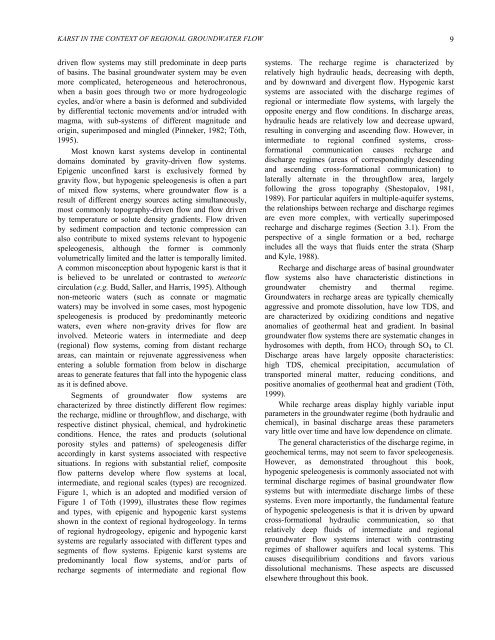Download PDF - Speleogenesis
Download PDF - Speleogenesis
Download PDF - Speleogenesis
You also want an ePaper? Increase the reach of your titles
YUMPU automatically turns print PDFs into web optimized ePapers that Google loves.
KARST IN THE CONTEXT OF REGIONAL GROUNDWATER FLOW<br />
driven flow systems may still predominate in deep parts<br />
of basins. The basinal groundwater system may be even<br />
more complicated, heterogeneous and heterochronous,<br />
when a basin goes through two or more hydrogeologic<br />
cycles, and/or where a basin is deformed and subdivided<br />
by differential tectonic movements and/or intruded with<br />
magma, with sub-systems of different magnitude and<br />
origin, superimposed and mingled (Pinneker, 1982; Tóth,<br />
1995).<br />
Most known karst systems develop in continental<br />
domains dominated by gravity-driven flow systems.<br />
Epigenic unconfined karst is exclusively formed by<br />
gravity flow, but hypogenic speleogenesis is often a part<br />
of mixed flow systems, where groundwater flow is a<br />
result of different energy sources acting simultaneously,<br />
most commonly topography-driven flow and flow driven<br />
by temperature or solute density gradients. Flow driven<br />
by sediment compaction and tectonic compression can<br />
also contribute to mixed systems relevant to hypogenic<br />
speleogenesis, although the former is commonly<br />
volumetrically limited and the latter is temporally limited.<br />
A common misconception about hypogenic karst is that it<br />
is believed to be unrelated or contrasted to meteoric<br />
circulation (e.g. Budd, Saller, and Harris, 1995). Although<br />
non-meteoric waters (such as connate or magmatic<br />
waters) may be involved in some cases, most hypogenic<br />
speleogenesis is produced by predominantly meteoric<br />
waters, even where non-gravity drives for flow are<br />
involved. Meteoric waters in intermediate and deep<br />
(regional) flow systems, coming from distant recharge<br />
areas, can maintain or rejuvenate aggressiveness when<br />
entering a soluble formation from below in discharge<br />
areas to generate features that fall into the hypogenic class<br />
as it is defined above.<br />
Segments of groundwater flow systems are<br />
characterized by three distinctly different flow regimes:<br />
the recharge, midline or throughflow, and discharge, with<br />
respective distinct physical, chemical, and hydrokinetic<br />
conditions. Hence, the rates and products (solutional<br />
porosity styles and patterns) of speleogenesis differ<br />
accordingly in karst systems associated with respective<br />
situations. In regions with substantial relief, composite<br />
flow patterns develop where flow systems at local,<br />
intermediate, and regional scales (types) are recognized.<br />
Figure 1, which is an adopted and modified version of<br />
Figure 1 of Tóth (1999), illustrates these flow regimes<br />
and types, with epigenic and hypogenic karst systems<br />
shown in the context of regional hydrogeology. In terms<br />
of regional hydrogeology, epigenic and hypogenic karst<br />
systems are regularly associated with different types and<br />
segments of flow systems. Epigenic karst systems are<br />
predominantly local flow systems, and/or parts of<br />
recharge segments of intermediate and regional flow<br />
systems. The recharge regime is characterized by<br />
relatively high hydraulic heads, decreasing with depth,<br />
and by downward and divergent flow. Hypogenic karst<br />
systems are associated with the discharge regimes of<br />
regional or intermediate flow systems, with largely the<br />
opposite energy and flow conditions. In discharge areas,<br />
hydraulic heads are relatively low and decrease upward,<br />
resulting in converging and ascending flow. However, in<br />
intermediate to regional confined systems, crossformational<br />
communication causes recharge and<br />
discharge regimes (areas of correspondingly descending<br />
and ascending cross-formational communication) to<br />
laterally alternate in the throughflow area, largely<br />
following the gross topography (Shestopalov, 1981,<br />
1989). For particular aquifers in multiple-aquifer systems,<br />
the relationships between recharge and discharge regimes<br />
are even more complex, with vertically superimposed<br />
recharge and discharge regimes (Section 3.1). From the<br />
perspective of a single formation or a bed, recharge<br />
includes all the ways that fluids enter the strata (Sharp<br />
and Kyle, 1988).<br />
Recharge and discharge areas of basinal groundwater<br />
flow systems also have characteristic distinctions in<br />
groundwater chemistry and thermal regime.<br />
Groundwaters in recharge areas are typically chemically<br />
aggressive and promote dissolution, have low TDS, and<br />
are characterized by oxidizing conditions and negative<br />
anomalies of geothermal heat and gradient. In basinal<br />
groundwater flow systems there are systematic changes in<br />
hydrosomes with depth, from HCO3 through SO4 to Cl.<br />
Discharge areas have largely opposite characteristics:<br />
high TDS, chemical precipitation, accumulation of<br />
transported mineral matter, reducing conditions, and<br />
positive anomalies of geothermal heat and gradient (Tóth,<br />
1999).<br />
While recharge areas display highly variable input<br />
parameters in the groundwater regime (both hydraulic and<br />
chemical), in basinal discharge areas these parameters<br />
vary little over time and have low dependence on climate.<br />
The general characteristics of the discharge regime, in<br />
geochemical terms, may not seem to favor speleogenesis.<br />
However, as demonstrated throughout this book,<br />
hypogenic speleogenesis is commonly associated not with<br />
terminal discharge regimes of basinal groundwater flow<br />
systems but with intermediate discharge limbs of these<br />
systems. Even more importantly, the fundamental feature<br />
of hypogenic speleogenesis is that it is driven by upward<br />
cross-formational hydraulic communication, so that<br />
relatively deep fluids of intermediate and regional<br />
groundwater flow systems interact with contrasting<br />
regimes of shallower aquifers and local systems. This<br />
causes disequilibrium conditions and favors various<br />
dissolutional mechanisms. These aspects are discussed<br />
elsewhere throughout this book.<br />
9
















